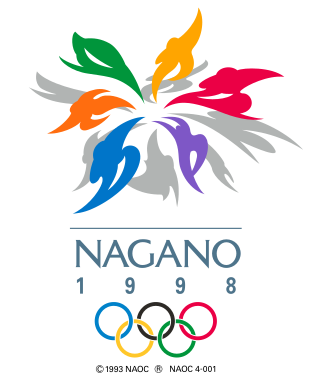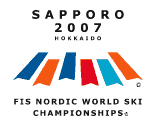
The 1998 Winter Olympics, officially known as the XVIII Olympic Winter Games and commonly known as Nagano 1998, were a winter multi-sport event held from 7 to 22 February 1998, mainly in Nagano, Nagano Prefecture, Japan, with some events taking place in the nearby mountain communities of Hakuba, Karuizawa, Nozawa Onsen, and Yamanouchi. The city of Nagano had previously been a candidate to host the 1940 Winter Olympics, as well as the 1972 Winter Olympics, but had been eliminated at the national level by Sapporo on both occasions.

The 1984 Winter Olympics, officially known as the XIV Olympic Winter Games and commonly known as Sarajevo '84, were a winter multi-sport event held between 8 and 19 February 1984 in Sarajevo, Yugoslavia. It was the first Winter Olympic Games held in a Slavic language-speaking country, as well as the only Winter Olympics held in a communist country before the 2022 Winter Olympics in Beijing, China. It was the second consecutive Olympic Games held in a communist country, after the 1980 Summer Olympics in Moscow, Russian SFSR, Soviet Union.

The 1936 Winter Olympics, officially known as the IV Olympic Winter Games and commonly known as Garmisch-Partenkirchen 1936, were a winter multi-sport event held from 6 to 16 February 1936 in the market town of Garmisch-Partenkirchen, Germany. Germany also hosted the 1936 Summer Olympics, which were held in Berlin. It was the last year in which the Summer and Winter Games both took place in the same country.
The 1972 Winter Olympics, officially the XI Olympic Winter Games [dai dʑɯitɕi-kai oɾinpikɯ tokikʲogi taikai] and commonly known as Sapporo 1972, were a winter multi-sport event held from February 3 to 13, 1972, in Sapporo, Hokkaido Prefecture, Japan. It was the first Winter Olympic Games to take place outside Europe and North America.

Nordic combined at the 1998 Winter Olympics, consisted of two events, held from 13 February to 20 February. The ski jumping portion took place at Hakuba Ski Jumping Stadium, while the cross-country portion took place at Snow Harp.
Nordic combined at the 1976 Winter Olympics, consisted of one event, held from 8 February to 9 February at Seefeld.
Nordic combined at the 1980 Winter Olympics, consisted of one event, held from 18 February to 19 February. The ski jumping portion took place at Lake Placid Olympic Ski Jumping Complex, while the cross-country portion took place at Lake Placid Olympic Sports Complex Cross Country Biathlon Center.
Nordic combined at the 1984 Winter Olympics, consisted of one event, held from 11 February to 12 February. The ski jumping portion took place at Igman Olympic Jumps, while the cross-country portion took place at Igman.

Nordic combined at the 1994 Winter Olympics, consisted of two events, held from 18 February to 24 February. The ski jumping portion took place at Lysgårdsbakken, while the cross-country portion took place at Birkebeineren Ski Stadium.
Nordic combined at the 1988 Winter Olympics consisted of two events, held from 23 February to 28 February. The ski jumping portion took place at Canada Olympic Park, while the cross-country portion took place at Canmore Nordic Centre.
Nordic combined at the 1948 Winter Olympics consisted of one event, held from 31 January to 1 February. The ski jumping portion took place at Olympiaschanze St. Moritz, while the cross-country portion took place around the hills of St. Moritz.
Nordic combined at the 1956 Winter Olympics consisted of one event, held from 29 January to 31 January. The ski jumping portion took place at Trampolino Olimpico, while the cross-country portion took place at Lo Stadio della neve.
Nordic combined at the 1960 Winter Olympics consisted of one event, held from 21 February to 22 February. The ski jumping portion took place at Papoose Peak Jumps, while the cross-country portion took place at McKinney Creek Stadium.

The FIS Nordic World Ski Championships 2007 took place 22 February – 4 March 2007 in Sapporo, Japan. It was the second time this city has hosted these championships, having previously done so in the 1972 Winter Olympics. Sapporo was selected as venue by vote at the 43rd FIS World Congress in Portorož, Slovenia, on 6 June 2002. It also marked the third time the championships were hosted outside Europe in a year that did not coincide with the Winter Olympics; it was the first championship held in Asia. The ski jumping team normal hill event was not held, as it had been in 2005.

Japan competed at the 1992 Winter Olympics in Albertville, France, from February 8 to February 23, 1992. As many as 63 athletes competed accompanied by 42 officers. Japanese athletes compete in all disciplines except ice hockey.
The Men's sprint Nordic combined competition for the 2006 Winter Olympics was held in Pragelato, Italy. It took place on 21 February.
The Men's individual Gundersen Nordic combined competition for the 2006 Winter Olympics was held in Pragelato, Italy. It took place on 11 February.
The Men's team Nordic combined competition for the 2006 Winter Olympics was held in Pragelato, Italy. It was originally scheduled for 15 February, but high winds meant that only part of the ski jumping competition was completed on that day, with the conclusion, and the cross-country race, taking place on 16 February.
The men's team large hill/4 x 5 km Nordic combined competition for the 2010 Winter Olympics in Vancouver, Canada was held at Whistler Olympic Park in Whistler, British Columbia on 23 February. The Austrian team of Michael Gruber, Christoph Bieler, Felix Gottwald, and Mario Stecher were the defending Olympic champions. Gruber retired after the 2007-08 season. Gottwald originally retired after the 2006-07 World Cup season, but came out of retirement in May 2009 to compete for the 2009-10 World Cup season including the 2010 Games. The defending world champions were the Japanese team of Yūsuke Minato, Taihei Kato, Akito Watabe, and Norihito Kobayashi. The last World Cup event prior to the 2010 Games in this format took place on 12 December 2009 in Harrachov, Czech Republic, but that event was cancelled on 4 December 2009 to warm weather and lack of snow. A team normal hill event took place prior to the 2010 Winter Games in Schonach, Germany on 24 January 2010 and was won by the German team of Georg Hettich, Eric Frenzel, Björn Kircheisen, and Tino Edelmann.
For the 1972 Winter Olympics in Sapporo, Japan, a total of twelve sports venues were used. A thirteenth venue which was a reserved luge course was constructed, but never used in actual competition. Construction on all of the venues used took place between 1968 and early 1971 in time for the test events. The Tsuskisamu Indoor Skating Rink was not completed until late 1971 or early 1972 because the number of teams scheduled to compete at the 1972 Games was not known. At the actual luge venue used, a malfunctioning starting gate during the first run led to the results being cancelled and rerun being ordered. The results of this event led to the only tie in Olympic luge history. The ski jumps at Miyanomori and Okurayama served as host venues for the FIS Nordic World Ski Championships thirty-five years later.







